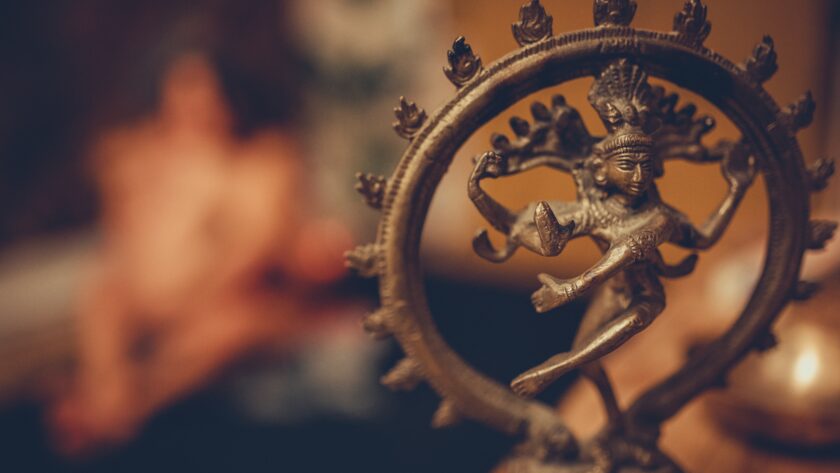In Ayurveda, traditional Indian medicine, the doshas refer to the three vital forces or energies that govern our physiology and personality. They are Vata, Pitta and Kapha. The term ‘dosha’ comes from Sanskrit and literally translates as ‘that which can become unbalanced’. Each dosha is intimately linked to the five elements of nature: space, air, fire, water and earth. These elements form the basis of all material existence, including our bodies. It is essential to understand that each individual possesses a unique blend of these three doshas, which forms his or her constitution or ‘prakriti’. Understanding the doshas can help to maintain balance and health in daily life. In this article, we will explore the doshas in Ayurveda and their importance for health.
The Three Doshas : Vata, Pitta and Kapha

Vata Dosha
It is made up of ether/space and air. Vata is the energy of movement. It governs all movement in the body, including breathing, communication, blood circulation and the transmission of nerve impulses.
Physically, if Vata is predominant in your constitution, you may have a thin, light body, with a tendency not to put on weight easily. Your skin may be dry and cold to the touch, and you may have a tendency to feel the cold more intensely than others.
Emotionally, you may be imaginative and creative, but also prone to anxiety and restlessness when Vata is out of balance.
Pitta Dosha
The Pitta dosha is made up of fire and water. It is the energy of transformation. It is responsible for all chemical and metabolic transformations in the body. It is the dosha that orchestrates the digestion and assimilation of food, transforming nutrients into usable energy. It is also responsible for regulating body temperature and skin colour. Pitta also influences our intellect and our understanding of the world. It governs our ability to analyse, understand and perceive reality. Emotionally, Pitta is linked to strong, intense emotions such as joy, anger and jealousy.
If Pitta is predominant in your constitution, you may have a muscular body, skin that is warm to the touch and a tendency to be intensely hungry and thirsty. You may have strong digestion and a fast metabolism.
Emotionally, you can be passionate, intelligent and determined, but also prone to anger and criticism when Pitta is out of balance.
Kapha Dosha
Finally, the Kapha dosha is made up of water and earth. It is the energy of structure and lubrication. It gives the body its physical form, nourishes cells and tissues, and lubricates joints.
If Kapha is predominant in your constitution, you may have a strong, robust body, soft, oily skin and a tendency to put on weight more easily than others.
Emotionally, you may be naturally calm, loving and patient, but also prone to laziness and resistance to change when Kapha is out of balance.
Understanding the Doshas in Ayurveda
How to Identify your Dominant Dosha
To find out your predominant dosha in Ayurveda, one of the methods frequently used is to fill in a detailed questionnaire. These questionnaires take into account your physical features, eating habits, typical behaviour, character and emotional reactions. Depending on your answers, you can determine whether your constitution is dominated by Vata, Pitta, Kapha, or a combination of these.
Several questionnaires are available online. However, it is essential to understand that these self-assessment tools serve as a starting point. They are not a substitute for a professional Ayurvedic consultation. A qualified Ayurvedic practitioner can carry out a more in-depth and precise analysis of your constitution. This professional will question you about your daily habits, your physical constitution, your eating habits, your sleep patterns and your personality to determine your dominant dosha and any imbalances.
Primary and Secondary Doshas
The individual constitution in Ayurveda is generally dominated by one or two doshas. These most prevalent doshas are called primary doshas. They have a major impact on our health and wellbeing.
However, we also have secondary doshas, which, although they have a less significant influence on our constitution, are not to be neglected. For example, it is possible to have a dominant Vata dosha (primary dosha), but also a significant presence of the Pitta dosha (secondary dosha).
In modern society, an imbalance of the Vata dosha in Ayurveda is frequently observed. Factors such as a fast-paced lifestyle, constant exposure to information overload, frequent travel and unbalanced eating habits can all contribute to this Vata dosha imbalance. It is therefore very important to take care to balance this dosha.
The Importance of Doshas Balance
How Doshas Imbalances Affect your Health
According to Ayurveda, health is a dynamic harmony between body, mind and environment. The doshas play a crucial role in this balance. When our doshas are balanced, we feel fit, energetic and happy. On the other hand, an imbalance of the doshas can lead to a variety of health problems.
This imbalance can result from a number of factors, such as an inappropriate diet, stress, lack of sleep, or even seasonal changes. For example, a diet that is too rich and fatty can exacerbate the Kapha dosha, leading to feelings of heaviness, laziness or congestion. Similarly, excessive mental or physical stimulation can unbalance Vata, causing anxiety, sleep disturbance or constipation. An imbalance in the Pitta dosha can be caused by eating too much spice or acid or by excessive exposure to the sun. This can manifest as irritability, heartburn or skin problems.
Identifying the Symptoms of Imbalance in each Dosha
A specific dosha imbalance manifests itself through particular symptoms. Here are a few examples:
- Vata out of balance: If your Vata dosha is out of balance, you may feel restless, anxious, afraid or have trouble sleeping. Physically, you may experience constipation, joint pain or dry skin.
- Pitta imbalance: When a Pitta imbalance occurs, you may feel irritable, short-tempered or critical. Physically, you may develop skin problems such as rashes or acne, or suffer from heartburn or diarrhoea.
- Kapha out of balance: If Kapha is out of balance, you may feel listless, depressed or resistant to change. Physically, you may gain weight, experience congestion or breathing problems, or suffer from water retention.
It is important to stress that these symptoms are only general indications and that each person may manifest different symptoms of imbalance. If you suspect a dosha imbalance, please do not hesitate to contact me for personalised Ayurvedic advice.
Ayurvedic Nutrition and Doshas: How to Optimise your Diet
Favourable and Unfavourable Foods for each Dosha
Nutrition has a decisive impact on maintaining the balance of the doshas. In Ayurveda, each food has specific characteristics that can either promote balance or cause an imbalance in each dosha.
Let’s take the example of the Vata dosha, which is characterised by coldness, lightness and dryness. Warm, heavy, moist foods are recommended, such as soups, cooked cereals and nuts. Cold, raw and dry foods, such as salads and crisps, should be avoided.
For the Pitta dosha, which is hot, light and moist, fresh, heavy and dry foods are recommended, such as fresh fruit (apricot, melon, peach, apple, pear), green vegetables (chard, broccoli, spinach, cucumber) and wholegrain cereals (oats, wheat, spelt, rice). Spicy, acidic and salty foods, which can aggravate Pitta heat, should be limited.
Finally, for the Kapha dosha, which is cold, heavy and damp, warm, light and dry foods are recommended, such as cooked vegetables, spices and pulses. Cold, heavy and fatty foods, such as cheese, desserts and fried foods, should be avoided.
The Six Tastes of Ayurveda and their Impact on the Doshas
Ayurveda distinguishes six tastes: sweet, sour, salty, bitter, pungent and astringent. Each taste has a different influence on each dosha:
- Sweet taste (such as cereals, milk, ripe fruit) soothe Vata and Pitta, but can upset Kapha.
- Sour taste (like citrus fruits, yoghurt, tomatoes) stabilises Vata, but can upset Pitta and Kapha.
- Salty taste (such as seafood, sea salt, garlic, onion, chives) balances Vata, but can aggravate Pitta and Kapha.
- Bitter taste (such as green vegetables, turmeric, dark chocolate) harmonises Pitta and Kapha, but can unbalance Vata.
- Pungent taste (like chillies, garlic, spices) balances Kapha, but can unbalance Vata and Pitta.
- Astringent taste (such as legumes, green tea, apples) harmonise Pitta and Kapha, but can upset Vata.
Ayurvedic Cuisine: A Tool for Harmonising the Doshas
Ayurvedic cuisine aims to create harmony between flavours and doshas in order to maintain and restore balance to the body. It considers not only the ingredients, but also the way in which the food is prepared and eaten.
In Ayurvedic cooking, it is essential to prepare food with love and care, to eat it in a peaceful and pleasant environment, and to listen to your body’s signals of hunger and satiety. In addition, choosing fresh, local and seasonal foods is a plus.
The ultimate aim of Ayurvedic cuisine is not only to nourish the body, but also to support the overall health, wellbeing and fulfilment of each individual.
The Daily Influence on the Doshas: Lifestyle, Activities and Seasons
Physical Activities Appropriate for Each Dosha
Physical activity is a powerful tool for maintaining the balance of the doshas. However, it is important to note that each dosha benefits from specific types of exercise:
- For the Vata dosha, which is characterised by mobility and lightness, gentle, soothing exercises are recommended, such as yoga, walking and swimming.
- For the Pitta dosha, which is intense and concentrated, moderate and refreshing activities are ideal, such as cycling, hiking or yoga.
- For the Kapha dosha, which is stable and heavy, dynamic and stimulating exercises are recommended, such as running, aerobics or team sports.
It’s essential to remember that exercise should always be adapted to individual abilities and provide a sense of pleasure and wellbeing.
Daily Routines for Balancing the Doshas
Ayurveda recommends a regular daily routine to help maintain the balance of the doshas. This routine can include regular sleep patterns, meals at set times, and time for relaxation and meditation.
- To balance Vata, it is advisable to have a regular routine, go to bed early and get up early, and take breaks to rest and relax.
- To balance Pitta, it’s advisable to cool off during the hottest part of the day, avoid overwork and take time to enjoy nature.
- To balance Kapha, getting up early, staying active during the day and avoiding daytime naps are beneficial practices.
The Doshas and the Influence of the Seasons
According to Ayurveda, the doshas are also influenced by the cycle of the seasons. For example, Vata is generally more dominant during autumn and winter, Pitta during late spring and summer, and Kapha during late winter and early spring.
By being aware of these seasonal variations, we can adjust our diet, physical activity and daily routine to maintain the balance of the doshas throughout the year.
The Doshas in Relation to Mental Health and Emotional Wellbeing
Yoga for Every Dosha
Meditation and yoga postures are valuable resources for keeping the doshas in balance and promoting mental health. However, each dosha can benefit from specific types of practice.
For the Vata dosha, mindfulness meditation is particularly recommended for Vata individuals. It helps to anchor the mind, which tends to be restless and scattered in the Vata dosha. Attention to the breath or to the physical sensation of the body helps to stabilise the mind. Transcendental meditation, which uses a mantra to help refocus the mind, can also be beneficial. Gentle, calming yoga is generally most appropriate. This could include forms of yoga such as Hatha Yoga, Restorative Yoga or Yin Yoga. These forms of yoga tend to be slower and focus on holding postures for longer periods of time. They can help anchor the light, mobile energy of Vata and promote relaxation and stress reduction.
For the Pitta dosha, meditation on compassion or loving heart meditation (Metta Bhavana) is often recommended. These types of meditation help to temper Pitta’s tendency towards anger or frustration and to cultivate empathy and patience. Meditation on nature, such as visualising a tranquil lake or soothing twilight, can also help to cool Pitta’s energy. Yin yoga, which emphasises relaxation and cooling, can be a good option. Similarly, gentle yoga or Hatha Yoga, practised with a mindset of non-competition and acceptance, can also help to balance Pitta energy.
For the Kapha dosha, more active and stimulating meditation can be beneficial. Moving meditation, such as walking meditation, can help balance the slower, more stable Kapha energy. Meditation focused on motivation and achieving goals can also be helpful in countering the tendency to become complacent or resistant to change. More dynamic and challenging yoga can be helpful. This could include forms of yoga such as Vinyasa Yoga or Ashtanga Yoga. These forms of yoga are generally more physically demanding and can help to stimulate Kapha energy, promote circulation and counteract the tendency towards stagnation or inertia.
Doshas-based Stress Management: Methods and Techniques
Stress is a major disturbance to the balance of the doshas, and each dosha can benefit from specific stress management methods:
- For the Vata dosha, which tends to be easily overwhelmed, relaxation techniques such as deep breathing, massage or listening to soft music can be effective.
- For the Pitta dosha, which can be prone to irritation and frustration, relaxation and release techniques such as walking in nature, swimming or art therapy can be useful.
- For the Kapha dosha, which can tend towards apathy and resistance, dynamic and stimulating techniques such as physical exercise, dancing or singing can be beneficial.
Doshas and Social Relations: How our Doshas Influence our Social Commitment
The doshas can also influence the way we interact socially:
- Vata-dominant individuals are generally enthusiastic, lively and spontaneous in their interaction with others. They are often creative and full of ideas, which can make them captivating and stimulating in social relationships. However, their changeable nature can sometimes make them a little unpredictable or fickle.
- Pitta-dominant individuals are often natural leaders and are known for their determination and competitive spirit. They are generally very focused and can be very convincing in their interactions. However, their tendency to want to be on top can sometimes make them critical or impatient.
- Kapha-dominant individuals are generally quiet, stable and loyal. They are often the “rock” on which others can rest, offering support and comfort. However, their resistance to change can sometimes make them too stubborn or complacent.
Understanding these tendencies can help us improve our interpersonal relationships, develop empathy for ourselves and others, and flourish as social individuals.
A Final Word
Understanding the doshas and their impact on our health and wellbeing is an invaluable way of leading a more balanced and harmonious life. It’s a personal and ongoing journey of self-awareness, adaptation and self-care.
Ayurveda invites us to see ourselves not as isolated individuals, but as beings in harmony with nature, influenced by the elements and the rhythms of life. It encourages us to take care of our body, mind and soul in a holistic and preventive way.
Ultimately, knowledge of the doshas can increase our awareness of who we are, how we function, and how we can lead healthier, more fulfilling lives. Ayurveda is not a panacea, but rather a valuable compass for navigating life’s journey with wisdom, compassion and joy.
Frequently Asked Questions (FAQs)
How can I Determine my Dosha?
I invite you to make an appointment with me!
Does Everyone Have the Three Doshas?
Yes, each individual has a unique combination of the three doshas.
What if I Have two Balanced Doshas?
If you have two balanced doshas, this means that you have a “bidosha” type of constitution. This is perfectly normal. In this case, it is advisable to take care of each dosha by respecting its respective principles, particularly in terms of diet, physical activity and daily routine.
Can my Dosha Change Over time?
Your birth dosha, or ‘prakriti’, remains the same throughout your life. However, your current dosha, or ‘vikriti’, can change depending on various factors such as lifestyle, diet, stress, season and age. It is therefore important to adapt your lifestyle to maintain the balance of your doshas.
How Can I Balance my Doshas in the Event of Illness?
In the case of illness, it is advisable to consult a qualified Ayurvedic practitioner for personalised advice. Balancing the doshas in the case of illness may involve dietary changes, herbs, detoxification treatments, adjustments to daily routine, breathing and relaxation exercises, and other therapies.
Are there any Contraindications to Following a Dosha Diet?
Ayurvedic dietetics is generally considered to be safe and beneficial for most people. However, each individual is unique, and what works for one person may not work for another. It is therefore advisable to consult a qualified Ayurvedic practitioner before making any major changes to your diet, especially if you have pre-existing health conditions.



